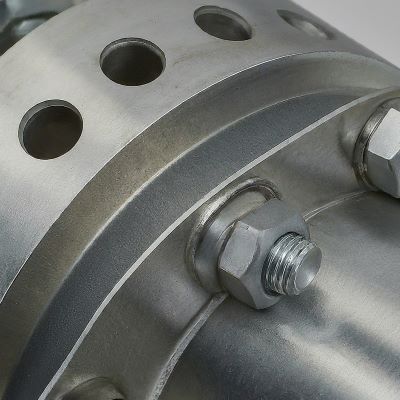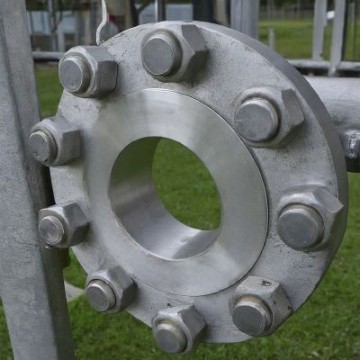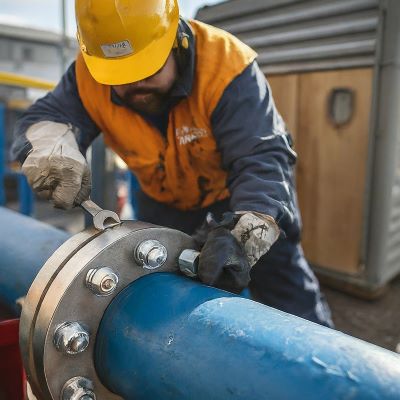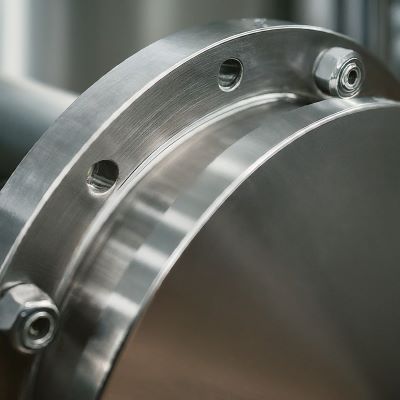O-ring flanges are crucial components in fluid systems. They play a vital role in creating reliable and leak-free connections. These flanges use O-rings. O-rings are circular elastomeric seals. They establish a tight seal between two mating surfaces. A flange and an O-ring together prevent fluid leakage. They work effectively and efficiently in various applications.
What is an O-Ring Flange?
Imagine a flange, a collar-like component typically bolted to pipes or equipment. But with a crucial twist. Nestled within its groove lies a toroidal wonder: the O-Ring. This donut-shaped seal is made from resilient elastomers like silicone or PTFE. It forms the heart of the O-Ring flange’s magic. When compressed between the flange faces, the O-Ring deforms. It fills every microscopic gap. It creates an impenetrable barrier against even the most determined leaks.
Types of O-Ring Flanges
The versatility of O-Ring flanges shines through their diverse forms. Each design caters to specific needs:
➡️ Simple and compact single-bolt flanges.
➡️ Robust and high-pressure capable multi-bolt flanges.
➡️ Blind flanges for sealing off the end of a pipeline.
➡️ Weld neck flanges for permanent integration into piping systems.
➡️ Stub end flanges for butt welding to larger pipes.
The Science Behind the Seal
A. How O-Ring Flanges Work:
The magic of an O-Ring flange lies in the delicate interplay of pressure and material properties. As bolts tighten the flange faces, the O-Ring compresses and expands. It fills every nook and cranny. Its inherent elasticity allows it to conform to even the slightest imperfections. This ensures a watertight seal. The chosen material plays a crucial role. It withstands the specific pressures, temperatures, and chemical environments the flange encounters.
B. Role in Fluid Sealing:
O-Ring flanges are the gatekeepers of countless fluid systems. They prevent precious liquids, from delicate pharmaceuticals to corrosive chemicals, from escaping or contaminating the surrounding environment. Their reliable sealing ensures the efficient operation of machinery. It protects personnel from hazardous leaks and safeguards the integrity of sensitive processes.
C. Seal Integrity and Leak Prevention:
Leakage isn’t just an inconvenience; it can have dire consequences. O-Ring flanges minimize this risk through their meticulous design and material selection. The O-Ring’s resilience to compression and its ability to recover its original shape after each use contribute to long-lasting sealing performance. Additionally, the flange faces themselves are precisely machined to ensure perfect alignment. They also provide optimal sealing pressure.
Design and Components
A. Anatomy of an O-Ring Flange:
An O-Ring flange is an orchestra of precision-crafted components working in harmony. The core elements include:
The Flange Body: Typically forged from metals like steel or stainless steel, it provides the foundation for the entire assembly.
The O-Ring Groove: Meticulously machines to house the O-Ring. This ensures its proper positioning and compression.
The O-Ring: The star of the show, this elastomeric marvel forms the primary seal against leaks.
Bolting Holes: These strategically placed holes allow for secure fastening of the flange to its mating component.
B. Materials and Construction:
The choice of materials for an O-Ring flange is critical. The flange body’s material must withstand the expected pressure, temperature, and chemical exposure. Popular options include carbon steel, stainless steel, and exotic alloys. They work well in highly corrosive environments. Meanwhile, the O-Ring itself is chosen based on its compatibility with the specific fluid. It’s also chosen for its ability to maintain its sealing properties under the operating conditions.
C. Variations in Design:
O-Ring flanges come in a kaleidoscope of designs to cater to diverse applications. Flange faces can be flat, raised, or with special grooves for enhanced sealing. Gaskets can be added for additional leak prevention. Surface finishes can be tailored to resist corrosion or ensure hygienic cleanliness.
Advantages of O-Ring Flanges
A. Enhanced Sealing Performance:
Compared to traditional flat gaskets, O-Ring flanges offer superior sealing capabilities. They can conform to imperfections and maintain consistent pressure. This minimizes the risk of leaks, even under challenging conditions.
B. Durability and Longevity:
Robust materials and meticulous design lend O-Ring flanges exceptional durability and longevity. They can withstand high pressures, extreme temperatures, and harsh chemicals. This translates to reduced maintenance costs and extended service life.
C. Compatibility with Various Fluids:
The versatility of O-Ring flange materials makes them compatible with a wide range of fluids. There’s an O-Ring flange configuration built to handle delicate pharmaceuticals and foodstuffs. There’s also one for corrosive chemicals and abrasive slurries. This broad compatibility makes them a go-to solution for diverse industries.
D. Ease of Installation and Maintenance:
Compared to bolted flanges with separate gaskets, O-Ring flanges offer simplicity and convenience. Their integrated design minimizes assembly time and complexity. The readily available O-Rings facilitate quick and easy replacements. This reduces downtime and maintenance costs.
E. Cost-Effectiveness:
The initial cost of an O-Ring flange could be slightly higher than traditional options. However, their superior sealing performance, durability, and ease of maintenance lead to significant long-term savings. O-Ring flanges are a cost-effective choice in the long run. This is because they reduce leak repairs and extend service life, leading to lower maintenance costs.
Applications of O-Ring Flanges
An O-ring flange being installed on a pipe
An O-ring flange sealing a tank of liquid
An O-ring flange used in a food processing plant
FAQs: Answering Your O-Ring Flanges Queries
How do I choose the right O-ring material for my flanges?
The choice of O-ring material depends on the specific requirements of your application. Factors such as temperature, pressure, and the type of fluid being conveyed influence the selection. Consult with O-ring material charts and guidelines for optimal choices.
Can O-ring flanges be reused?
In many cases, O-ring flanges can be reused if the O-ring is in good condition and the flange surfaces are not damaged. However, careful inspection is necessary to ensure the integrity of the seal before reuse.
What are the common causes of O-ring failure in flanges?
O-ring failure can result from factors such as improper installation, incompatible materials, or excessive wear. Understanding the causes of failure helps in implementing preventive measures. It also ensures the longevity of O-ring flanges.
Are O-ring flanges suitable for high-temperature applications?
Yes, O-ring flanges can be designed with materials that withstand high temperatures. Select O-rings and flanges compatible with your application’s temperature range. This is crucial. This ensures optimal performance.
Can O-ring flanges handle corrosive fluids?
Some O-ring materials, like fluorocarbon or PTFE, resist corrosion. They can handle corrosive fluids. Always check material compatibility charts and guidelines. Choose the right O-ring for your specific application.
What maintenance practices can extend the lifespan of O-ring flanges?
Regular inspections, proper lubrication during installation, and avoiding over-tightening are key maintenance practices. Replacing worn-out O-rings promptly helps O-ring flanges last longer. Fixing any flange surface damage also helps.
Final Say
O-Ring flanges are more than just components as they are the silent guardians of fluid systems. O-Ring flanges ensure leak-free operation and protect the integrity of processes. Their meticulous design and advanced materials make them versatile and reliable. They also come in diverse configurations and are used in a vast array of applications.
O-Ring flanges play a crucial role in keeping the world flowing smoothly and safely. So, the next time you come across these unsung heroes, remember the unsurpassed precision and power they wield in the realm of fluid sealing.
Post time: Feb-21-2024






